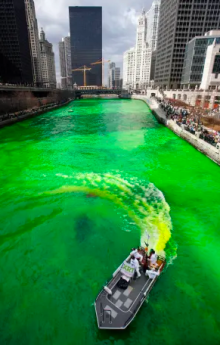
Every year on March 17, people, regardless of ethnicity, celebrate St. Patrick’s Day by wearing green clothing, attending parades and eating Irish potatoes.
The celebration of St. Patrick’s Day in the United States has taken its own spin in the last 150 years. It has morphed into a day where people head out to the bars to consume pints of beer or shots of whiskey. Consumer spending on St. Patrick’s day is expected to reach $5.61 Billion. The average person will spend about $40.18. A significant portion of the money will be spent on food, clothing, drinks and decorations.
However, St. Patrick, for whom the day is named, began as a religious holiday in Ireland one thousand years ago.
Who is St. Patrick?
St. Patrick was born in England in 387. When he was 14 he was kidnapped by Irish pirates who took him to Ireland. He was enslaved for six years as a shepherd. After this, he escaped and fled back to Britain.
According to Catholic Online, his faith and relationship with God were very important to him while in captivity. It played an influential role in his decision to enter the priesthood upon arriving home. After he became a priest, St. Patrick felt called to return to pagan Ireland as a missionary to spread Christianity. He was met with great opposition but through persistence, he converted thousands of people to Christianity. There are many legends about St. Patrick, including one where it was believed that he drove the snakes out of Ireland. The country is still void of snakes to this day. He died on March 17, 461. He is known as the patron saint of Ireland.
How did the celebration of St. Patrick’s Day start?

Historically speaking, Ireland has been a predominately Catholic country. Much of the Catholic traditions and practices have been intertwined with the government affairs. St. Patrick’s Day is an example of this. According to History Network, the Irish began celebrating St. Patrick’s Day in the 1000s and 1100s.
On March 17, the feast day of St. Patrick, the Irish would abstain from their Lenten practices and would celebrate with food, drinking, and dancing. It would later make its way overseas during the 1800s when millions of Irish citizens migrated to the United States.
Why did the Irish immigrate to the United States?
During the 1800s, the potato was an important part of the Irish tenant farmer’s diet. Potatoes were easy to grow, cheap and nutritious. Money was tight for the farmers, so it was a win-win situation. According to Encyclopedia Briticanna, “almost half the Irish population—but primarily the rural poor—had come to depend almost exclusively on the potato for their diet.”
Everything changed in 1845 when the potato crop failed. This catastrophe ushered in the era of the “Great Potato Famine” in which one million people died of starvation. During this time, 1.5 million Irish citizens immigrated to the United States in hopes of finding a better life. They moved to large metropolitan cities in the Northeast, such as Philadelphia, New York and Boston.
Kathleen Eckert, a soon-to-be member of the Ancient Order of Hibernians, noted that growing up in Montgomery Country, Pennsylvania St. Patrick’s Day was always a day that the Irish heritage was embraced.
“St. Patrick’s Day was a day that everyone celebrated…There’s always people who carry it too far all that,” Eckert said. “But the general spirit is to celebrate your heritage.”


